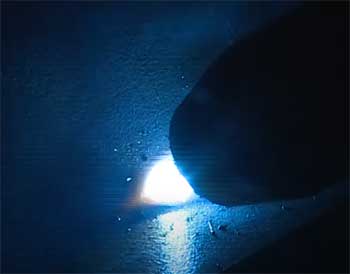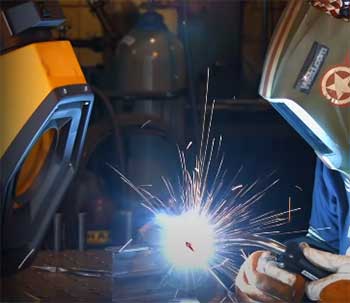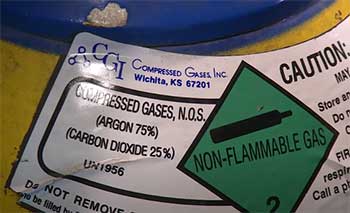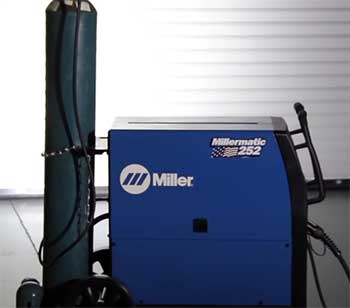When it comes to MIG welding, you come across this debate where you have to choose between MIG steel C25 and C100 shielding gas. One of the significant differences between the two options is their pricing and arc stability. C25 tends to have higher pricing and arc stability than C100.
You will notice some other little differences between the shielding gas types. You will learn about the differences when you go deep into the two gases and compare them. I have this in-depth comparison guide to help you choose the option for your project.
Let’s get started with it.
A Quick Comparison Table
| Specifications | MIG Steel C25 | MIG Steel C100 |
| Spatter | Less | More |
| Cost | Expensive | Less expensive |
| Arc stability | Strong | Weak |
| Range of metal | High | Low |
| Compatibility | Low | High |
| Weld bead appearance | Narrow bead | Broad bead |
Key Differences Between MIG steel C25 And C100 Shielding Gas
- Spatter

Right from the start, you have to think about the spatter you get from both gases for MIG welding.
Both the gases have spattering, but the C25 has much less spatter than the C100.
With C25, you get 2/3 or 1/3 times less spattering in general. It makes the C25 a better shielding gas to work with.
Because no matter what, you will always want a shielding gas that provides better spatter control.
C100 causes a lot of spattering when you compare it to C25. You will have a lot of trouble while welding with C100. So, if you want less spatter in your MIG welding process, go with C25 without overthinking.
Also Read: Problems With Lincoln Square Wave 200.
- Cost
Cost is crucial in choosing a shielding gas for your MIG welding purposes. There is a very significant difference between the two gases when it comes to their pricing of them.
If you want lower pricing, then C100 will always be your choice. They are a much more affordable choice for your shielding gas. The initial pricing on the C100 is much lower than you pay for the C25.
In C25, you may expect to pay 2 or 3 times the price of C100 in the initial cost. So, the difference between the two is very high and can impact your decision. You can save plenty of money if you opt for C100 over C25.
- Arc stability
A key factor of any weld is the arc quality or arc stability. Using the different gases will give you a different kind of arc stability. One is better, and one falls behind in terms of quality.
If you are after good arc stability and quality, go with C25. The mixture of carbon dioxide and Argon gives you that perfect arc support and makes it very stable.
On the other hand, with C100, you end up with a very poor-quality arc. The stability is just off. You can’t rely on the arc stability at all. So, if you want the best art stability in your welding, I have to pick C25, no doubt about that.
- Range of Metal

Where you can use each of these gases has a lot of impacts on your choice.
C25 is usable for more metals compared to C100.
The presence of Argon in C25 gives it the capability to work along with a variety of materials.
With C100, you are limited with the range of metal they cover. You can’t use them for too many different metals.
So, I have to say C25 is the perfect option if you want to work with various materials.
- Compatibility
The compatibility here refers to where you can use the two gases. Well, you will be using these gases in MIG welding. But can all MIG welders work with both gases? I have to say no. There is a difference in the compatibility factor for both.
When you choose to use C25, you will have low compatibility because not all the MIG welders are suited to work with C25. In contrast, you can use C100 with almost all kinds of MIG welders you find. That’s why in terms of compatibility, C100 is a better pick.
- Weld Bead Appearance
Here’s a factor that a lot of welders will consider before choosing a shielding gas. How the weld bead will appear in your welding is very important. There is a big difference in appearance.
Starting with the C25, you will get a bit of a narrow bead. It’s pretty deep in penetration but not that much in comparison. So, if you are working with a thin metal, C25 might be a good option. Because the bead will be narrow, it won’t have a bad appearance on the thin metal.
In contrast to that, C100 provides a bit broader bead. The bead also penetrates very deep into the metal. That’s why it’s much more suitable when working with heavy or wide metal.
Which Shielding Gas Is A Better Pick For You?

Well, most of the time, the better pick will depend on your projects.
But still, if you are considering the general factors, you can find a better choice based on that.
Let’s say you want to save money on the welding process, then directly go towards C100. They are much more cost-effective.
But if you wish for excellent arc stability, choose C25 without any doubt.
Considering these two factors should give you a good result for the most part. If you struggle after that, you can follow up on the in-depth comparison to find the answer.
Also Read: Differences Between PrimeWeld And Everlast Welders.
Frequently Asked Questions (FAQ)
MIG steel C25 is a shielding gas containing 25% carbon dioxide and 75% Argon.
C100 steel is a 100% pure carbon dioxide shielding gas for welding purposes.
C25 welding gas is mainly used for home and hobby projects.
Yes, you can easily MIG weld stainless steel with the mixture of carbon dioxide and Argon which is essentially C25.
Conclusion
To sum up, MIG steel C25 vs. C100 is all about the requirements of your projects. If the projects call for C25, then you use C25. It’s an expensive shielding gas, but it provides excellent art stability that you will love to have.
But if you want to do welding on a budget and your projects suit it, then you can go for the C100 as your shielding gas.

